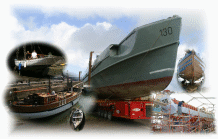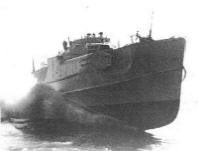


Re-Build ~ New Build ~ Repair
 |
 |
 |
| Shipwrights & Boatbuilders | ||
|
Project
Restorations Re-Build ~ New Build ~ Repair |
| Updated: 27 April 2012 | |
| S130 | |

 |
|
| WW2 German Schnellboot Restoration | |
Reconstruction - Part 1HullTimber Work |
|
June-July 2009 |
|
Repairing the damaged keel section. This involved cutting the offending section of keel back to the line of the garboard between the scarphs - as the after scarph is badly damaged, a new scarph was cut extending this section by a few feet.
The new 40ft keel section of superb quality French oak, sourced by Peter Clark of Timb-A-Haul Ltd, is bedded and bolted to the surviving 'hog' which carries the hull timbers (ribs). |
|
PHOTO GALLERIES: Click on 'Pictures' to view carousel. Click on displayed photo to view full size. Click again to return. |
|
The stern section of keel was victim of a multitude of 'dockyard' repairs which left us with very little good timber to work with, so it too required replacing with a new 10ft length of oak which is bedded and bolted into place |
|
September 2009 |
|
Patterns of the aluminium frames are taken New vertical transom frames are made. One pair of oak frames are of steam bent oak and are canted at each end to form a double set with exceptionally tight bends. To bend these we fabricated a steel former that supported the grain on three sides while the green oak was bent. |
|
|
|
May-July 2010
|
|
The transom was found to be significantly damaged and out of shape, probably due to collision coupled with many dubious repairs and degredation of age. A new transom is lofted to full size from drawings, combined with information obtained from the boat. Building and laminating jigs have then been built, from which the new transom framing is constructed in iroko. |
|
August-October 2010 |
|
The old transom is removed prior to lifting and fitting the new transom frame into place.
In order to lift and control the new transom frame, while accurately aligning and fitting it into place, we fabricated a mobile beam gantry, which will also be used to assist with the new stem. |
|
August-October 2010 |
|
Positioning the new transom shows how much the hull has lost shape in the stern over a lifetime of hard knocks, poor repairs and general neglect |
|
The photo below gives an indication of how much the deck line has dropped and the camber has flattened out. |

|
|
The sheer strakes and deck edge on the port and starboard side, from the transom to the No 1 engine room, have been removed to further reveal the loss of shape at the stern and damage to the stringers and aluminium stiffening. Planking and timbers are removed to reveal the frayed aluminium sheer clamp for which a correcting pattern has been made |